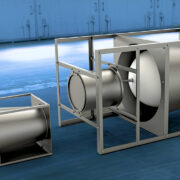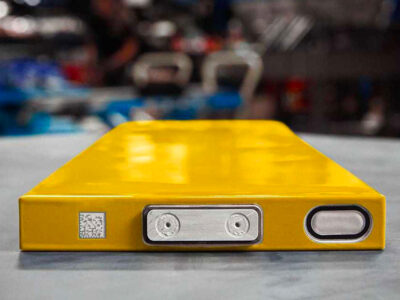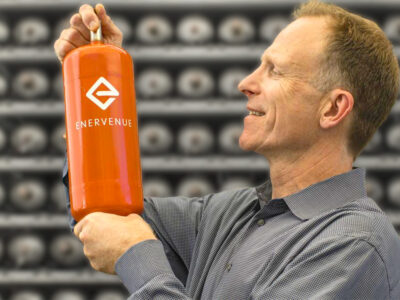Being cheaper, more energy dense and longer lasting than lithium-ion technology, lithium-sulfur batteries may be the holy grail of power storage. Besides fueling electric vehicles (EVs) adoption, they could turbocharge the integration of renewables into our energy grid. However, a technical fault has been holding back their economic feasibility…until now. An accidental, yet major discovery may have finally unlocked their full potential. Could this lithium sulfur discovery make it the future of battery storage?
Energy storage is the key to the future of renewables. It’s why I’m so fascinated by different battery technologies and talk about them so much. The king of the hill right now is lithium ion, which we’ve all used and know well. We’ve got them in our pockets in smartphones, on our wrists with smart watches, and now in our cars.
However, there’s another kid in town that’s been getting some attention: lithium-sulfur batteries. Over the last few years, they’ve been touted as a strong candidate for marking a new energy storage era, but they haven’t made it to the market yet. Now, a group of chemical engineers from Drexel University have found a way to enable their real-world application.1 I’ll get to that in a minute, but first let’s look at why a lithium-sulfur battery could be a revolutionary upgrade of lithium-ion technology.
The cathode of lithium-ion batteries is mostly made of critical minerals such as nickel and cobalt. Yet, our hunger for EVs is driving up the demand for these two raw materials. According to a recent study, Europe may face nickel and cobalt shortages as early as 2030.2 The report also predicts that the EU will need 100% more nickel and 330% more cobalt to become climate neutral by 2050. While our planet stock may be enough to meet these targets, cobalt and nickel sourcing is not keeping up with the demand. And that’s partly because of a slow progress in developing new mines. For example, in the US it takes up to 10 years to secure a mine permit.3 On top of that, we’re lacking processing facilities to turn the minerals into battery-friendly components. Coupled with an insane demand, the slow-moving supply chain leads to shortages of battery ingredients and therefore skyrocketing prices.4
Besides these problems, there are sustainability issues behind their production. 70% of global cobalt comes from the Democratic Republic of Congo (DCR)5, which has had some serious issues with forced and child labor. As for nickel processing, we currently rely on wasteful6 and carbon-intensive7 methods. In particular, Indonesian nickel is the least environmentally friendly, and there are concerns that they are dumping mining tailings into the sea, polluting the waters as well. 6 7
In contrast, being the 10th most abundant element on Earth8, sulfur is much easier to find than cobalt and nickel. Plus, it’s obtained as a by-product of various industrial processes such as petroleum refining.9 In other words, it’s a cheaper and greener feedstock. That’s why introducing sulfur in the cathode formulation would relieve the pressure on the EV supply chain and could reduce cars’ cost. Perhaps one of the chief benefits would be that a byproduct could be turned into a useful product.
Aside from saving on raw materials, using lithium-sulfur batteries could achieve up to 8x greater energy density than lithium-ion designs.10 What does that mean in practice? For instance, if you were to swap your EV lithium-ion battery with a lithium-sulfur one, you could drive your car roughly 8x longer without needing a recharging station. Or keep your existing range with a much smaller, lighter, and cheaper battery pack.
However, lithium sulfur batteries are not flawless. Their major problem is the so-called polysulfides shuttle.11 Basically, when the battery is discharging, an oily carbonate-based electrolyte carries lithium ions from the anode to the cathode. Here, the lithium ions react with the sulfur to form lithium sulfide.12 Well … it’s a bit more complicated than that, but the key point is that the reaction with the carbonate electrolyte creates an irreversible product. The trouble is that some of these compounds get lost into the electrolyte solution and during the charging stage are shuttled from the cathode towards the anode. Once they get there, polysulfides may convert into a solid form and cover the electrode with an insulating layer. Besides blocking the transport of lithium ions during the next discharging cycle, the irreversible buildup of this barrier bites into the cathode. You may see why these mechanisms reduce both the battery capacity and charging/discharging efficiency.13 Crazy as it sounds, a study found that the aggressive reaction between polysulfides and the carbonate electrolyte solution may shut down lithium sulfur batteries after the first cycle.14 In the best case scenario, you can recharge these devices no more than 100 times.15 And that’s nothing when you think that commercial lithium-ion batteries can last 2,000 cycles or more.16 That’s where Drexel researchers’ fortuitous light bulb moment comes in.
An accidental yet enlightening discovery
It’s not the first time scientists have found something by chance. Think of viagra for instance. It was being tested as a heart medication when a certain … um … let’s call it “side effect” caught their attention. Well, this lithium-sulfur discovery isn’t x-rated, but could lead to a new path for commercializing lithium sulfur batteries. With the aim of preventing polysulfides formation, the Drexel team tried to isolate sulfur from the carbonate solution by locking it inside the micropores of a carbon nanofiber matrix. As described in their paper published last February, they attempted that by using a vapor deposition technique. Yet, something didn’t quite work as expected. Instead of being trapped within the carbon framework, sulfur particles were just lying on top of its surface. And that’s when something even more unexpected happened. Despite sulfur particles and carbonate solution coming into contact, researchers couldn’t see any polysulfides. Puzzled by their experiment outcome, they repeated the test over 100 times. I reached out to Dr. Vibha Kalra, the paper’s lead author, to find out more on their lucky discovery.
“The first time we got this data, we thought it was an artifact. And that’s one of the reasons we ran almost a hundred cells. But of course, in addition to the repeatability aspect, we did a lot of other electrochemical tests to make sure that we were truly seeing a direct conversion from sulfur to lithium sulfide without polysulfides. It took us months to convince ourselves that this is truly a redox of sulfur going to lithium sulfide. And that’s what’s giving us this very high energy storage.” -Dr. Vibha Kalra
After further investigation, scientists figured out that, when changing from gas to solid, such as during vapor deposition coatings, sulfur turned into one of its most elusive forms: The so-called monoclinic gamma-phase sulfur.17 This doesn’t react with the carbonate-based electrolyte, which explains why polysulfides were nowhere to be seen. What nobody can still explain is how they created that phase, as it’s very rare and supposed to be unstable below 95 °C (203 °F).18 Despite the mystery, after a year of testing Dr. Kalra and her co-workers proved their sulfur cathode stabilization over 4,000 charge-discharge cycles, which is about 2x the duration of a lithium-ion battery.19 To add to that, their initial battery capacity is about 3x that boasted by the lithium-ion competition.20
Although this is not the first time scientists designed high-performance lithium-sulfur batteries, the Drexel group’s magic trick is bringing the device closer to mass production. Why’s that? Their unique solution eliminates the polysulfide creation completely. While other researchers have tried to minimize the effects by replacing the benchmark carbonate electrolyte with an ether-based solution, which doesn’t react in the same way. While this does address some of the polysulfide issues, it doesn’t stop the formation and also introduces a safety concern.21 These alternative electrolytes contain compounds with boiling points as low as 42 °C (ca. 108 °F).22 As the battery warms up during its operation, this will likely evaporate and the pressure buildup could then cause battery damage. It’s a big engineering issue.
Aside from greater safety, Dr. Kalra brought up another crucial advantage in using carbonate electrolyte.
“Carbonate electrolyte has been the electrolyte of choice for the lithium industry for the last 30 years. The industry has developed a lot of knowhow on these carbonate electrolytes. And that includes a wide range of additives that perform a wide range of functions, such as flame retardancy, solid electrolyte interface (SEI) formation and so on.” -Dr. Vibha Kalra
Which makes sense. It’s much easier to scale something up when using well-established industrial practices, right?
As a bonus of their fortunate sulfur-based cathode stabilization, researchers said they could try their luck using sodium instead of lithium for making the anode. And that would be a big improvement. To begin with, sodium is around 1,400x more abundant than lithium in the earth’s crust.23 Extracting and purifying lithium is more tricky and expensive than sodium as well. Just like cobalt and nickel, conventional batteries’ keystone has been experiencing supply crunches and rising prices. Since the beginning of 2022, the price of lithium doubled.24 In China, which is by far the world’s largest EV battery manufacturer25, lithium carbonate, the most common battery-grade lithium form on the market, saw a 7-fold price increase over the last year.26 You probably see why using sodium would make the battery way more affordable.
Lithium sourcing poses sustainability risks. Last January, green activists forced the Serbian government to scrap the Rio Tinto license for developing what would have been Europe’s biggest lithium mine by output.27 28 Protesters argued that the lithium mine would have polluted local water and land. Besides contaminating it, lithium extraction consumes a lot of water. To be more specific, around 500,000 gallons per ton of lithium.29 There are new techniques that are helping with that, which I’ve talked about in previous videos. I’ll include links to those in the description.
Anyway, the sodium incorporation is not on top of Drexel’s agenda as the team will first have to resolve the scientific and technological challenges associated with the current setup.
“So, scientifically we wanna understand the chemistry more and we want to more clearly answer the questions of how we are stabilizing the gamma sulfur at room temperature when it’s known to not stabilize under 95 °C (203 °F). We also want to understand how this particular crystal structure is enabling a complete change of redox phenomena in the lithium sulfur batteries. Technologically, we have run over a hundred cells to ensure the repeatability and reproducibility of our data at the lab level. So, the technological steps would be to scale up the production of this gamma sulfur and build prototype level batteries.” -Dr. Vibha Kalra
This sounds like a lot of work. So, how long will it take?
“We’ve been talking to a lot of industry folks to get an understanding of the steps beyond where we are right now. And our understanding for such a technology would be more in the range of five to six years.” -Dr. Vibha Kalra
I don’t know about you but this is much sooner than I expected. Also, assuming this technology eventually pans out, it won’t just improve EV range. Dr Karla highlighted some possible use cases.
“So I feel this could fit into many applications. For example, something like drones, right? Where the weight is an issue and at the same time we do need longer run times. Aerospace industry is another direction. So, there’s a lot of different applications.” -Dr. Vibha Kalra
But Dr Karla’s research group is not the only one advancing lithium sulfur battery technology. Interestingly, there’s a company who’s managed to accomplish a version of the carbon nanofiber matrix approach … somewhat similar to what Drexel’s team was working on originally. Lyten claims to have caged sulfur into 3D graphene structures, which mitigates the polysulfide shuttle effect.30 Additionally, their architecture features a coating on top of their lithium anode to inhibit the growth of dendrites, which is the other major cause for the failure of lithium sulfur batteries.31 As heralded by the California-based firm in a press release, their LytCell™ prototype battery can run for over 1,400 cycles under the Department of Defense test protocols.32 While their battery lifespan is not as long and robust as that measured by Drexel in the lab with their discovery, Lyten seems to be one step ahead along the way to the market. With a throughput of a quarter of a million cells per year, Lyten’s pilot plant is supposed to go online at some point in 2022.
Drexel’s unexpected yet radical achievement may be finally pulling the sought-after lithium sulfur battery within commercial reach. With lower cost, higher power density and greater durability, this technology would change the way we think about energy storage for good. Having said that, scientists will still need to prove their optimized device outside of the lab. So, our cars, smartphones and drones will have to wait a little longer before being supercharged to the next level. I’m pretty excited by what this could mean for the future of our EVs and renewable energy.
- “Stabilization of gamma sulfur at room temperature to enable the use ….” ↩
- “Europe’s Green Deal requires massive amounts of battery metals.” ↩
- “[INFOGRAPHIC] US Minerals mining permitting process.” ↩
- “Explainer: Costs of nickel and cobalt used in electric vehicle batteries.” ↩
- “Blood cobalt – ABC.” ↩
- “HPAL Nickel Tailings Question Still Unanswered – Anthony Milewski.” ↩ ↩
- “GHG emissions intensity for class 1 nickel by resource type and ….” ↩ ↩
- “Facts About Sulfur | Live Science.” ↩
- “Sulfur (PDF) – EPA Archive.” ↩
- “How Far Away Are Lithium-Sulfur Batteries From Commercialization?.” ↩
- “Work principle and polysulfide shuttle in Li-S batteries | IoLiTec.” ↩
- “Mixed Conduction Membranes Suppress the Polysulfide Shuttle in ….” ↩
- “Effective Suppression of the Polysulfide Shuttle Effect in Lithium ….” ↩
- “Effect of chemical reactivity of polysulfide toward carbonate-based ….” ↩
- “Li-sulfur Battery Rivals Cycle Life of Li-ion – ECS – The ….” ↩
- “Lithium-Ion vs Lead Acid Battery Life – Flux Power.” ↩
- “Solid Allotropes of Sulfur | Chemical Reviews.” ↩
- “’Gamma Sulfur’ May Hold the Key to Future Lithium-Sulfur Batteries.” ↩
- “Stabilization of gamma sulfur at room temperature to enable the use ….” ↩
- “Li-ion battery materials: present and future – ScienceDirect.” ↩
- “A new ether-based electrolyte for lithium sulfur batteries using a S ….” ↩
- “Breakthrough in Cathode Chemistry Clears Path for Lithium-Sulfur ….” ↩
- “How Comparable Are Sodium-Ion Batteries to Lithium-Ion ….” ↩
- “Lithium price forecast: Rising EV demand to cause new highs?” ↩
- “CATL Retains Top Position as World’s Biggest EV Battery Maker.” ↩
- “Chinese EVs get squeezed by rising lithium price and falling subsidies.” ↩
- “Explained: Why have Serbians been protesting over lithium mining?.” ↩
- “Serbia scraps plans for Rio Tinto lithium mine after protests.” ↩
- “The Earthly Impacts of Extracting Lithium.” ↩
- “Home – Batteries for Electric Vehicles from Lyten.” ↩
- “Suppressing the Shuttle Effect and Dendrite Growth in Lithium ….” ↩
- “PRESS RELEASE: Lyten Launches Lithium-Sulfur Battery Platform.” ↩















Comments